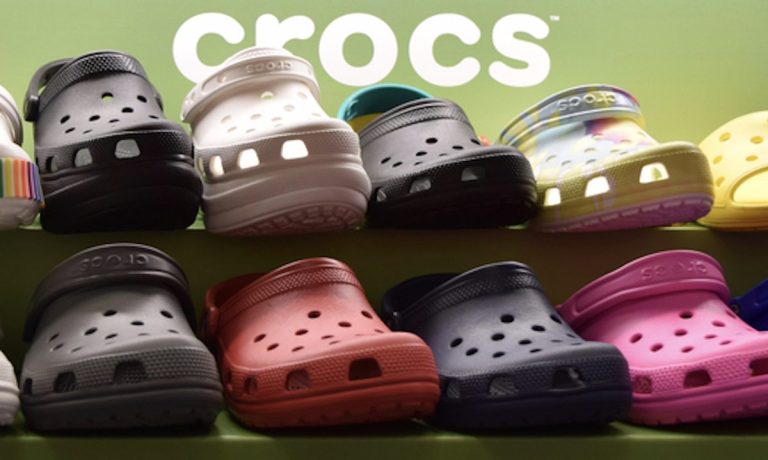
Several years ago, Crocs were the pariah of the footwear world. Even company executives admit it — during an investor presentation last week, Chief Marketing Officer Heidi Cooley said the brand is still working against its perception as “one of the most polarizing shoes in the industry.”
But in July, the company — benefiting from an increase in casualwear and consumers’ increased desire for comfort — reported $641 million of revenue in the second quarter, up 93% compared to 2020 and 79% compared to 2019, and projected $1.4 billion sales for the entire year, over 60% growth from 2020.
Related: Crocs’ Old Demand Problem Has Become Its New Supply Problem
Now, Crocs executives are aiming to more than triple that within the next five years, planning for $5 billion in sales by 2026, which translates to a compound annual growth rate (CAGR) of more than 17%. Half of those sales are expected to come from digital channels, including through Crocs.com and global eCommerce retailers, up from 37% currently.
“We are highly optimistic that Crocs has a very strong growth potential and are planning for a bold future,” Michelle Poole, president of Crocs Inc., told investors and analysts.
Among the key components of the strategy is an expansion of Crocs’ presence in Asia, particularly China, as well as creating more opportunities for personalization across the brand. Crocs CEO Andrew Rees noted that these are not new strategies for Crocs — rather, “they are the same critical areas of focus that allowed us to create almost $8 billion of value over the last six years.”
To be sure, Crocs will be battling against an increasingly crowded footwear market, with nearly every brand focused on comfort with fashion, something that some would likely say Crocs has yet to master despite an increase in the number of consumers looking to collect different versions of the clogs.
Adidas, for example, earlier this year set its own trajectory to double its eCommerce business over the next five years and shift more to a direct-to-consumer (D2C)-led strategy; part of that roadmap included offloading Reebok to Authentic Brands Group last month. Several D2C footwear companies, including On Holding and Allbirds, have also recently filed to go public.
Read more: Sneaker Startup IPOs Take a Run at Nike
Asian Expansion
Rees told investors that Crocs believes its greatest long-term growth opportunity is in Asia, with a 30% CAGR over the next five years leading to 25% of the brand’s business coming from the continent. First and foremost, the CEO noted, is China, the second-largest footwear market in the world at 20% of global footwear sales. Crocs currently has about 5% of its business coming from China. “Over the next five years, we believe that Asia will be our fastest-growing region,” Rees said.
Although Crocs has a plan for expansion in China that includes focusing on digital sales, better social media communication, new partnerships and opening retail locations within major cities, the brand’s penetration in the country is massively behind that of competitors. Rees said competitive brands have about 20% of their sales coming from mainland China.
Nike in particular has invested time and money in the Chinese market, seeing seven consecutive years of double-digit growth that executives expect to continue in the coming years. Adidas has also targeted Beijing as one of 12 influential “megacities,” or global hubs for trends and fashion, within key markets.
Still, Rees said he’s confident in Crocs’ “very focused strategy” for China. “I’m confident this will produce long-term growth in the Chinese market,” he predicted.
Prioritizing Personalization
The other major pillar in Crocs’ growth strategy is personalization — namely, increasing sales of Jibbitz, or charms that consumers can clip onto their shoes to make them unique. Poole said Crocs customers who buy Jibbitz have twice the average lifetime value of those who don’t, and the sale of Jibbitz is more about driving footwear purchases. “We have the ability to double our Jibbitz business and drive incremental market share through additional opportunities in personalization,” she said.
Crocs is also looking to expand its footwear offerings beyond clogs, with sales of the brand’s sandals projected to quadruple over the next five years. The brand’s socks, which launched this summer, are also expected to complement personalization efforts.
Poole said that unlike clogs, where the goal is to increase relevance for consumers, increasing sales of sandals is about driving awareness that Crocs sells them. The total addressable sandal market for Crocs is worth an estimated $30 billion, she noted.
“Sandals can be a year-round opportunity, particularly in the digital channel and our warmer markets,” Poole said. “And … it’s important to remember that sandals is not a trend-driven business. It’s based on wearing occasions that never go out of style.”